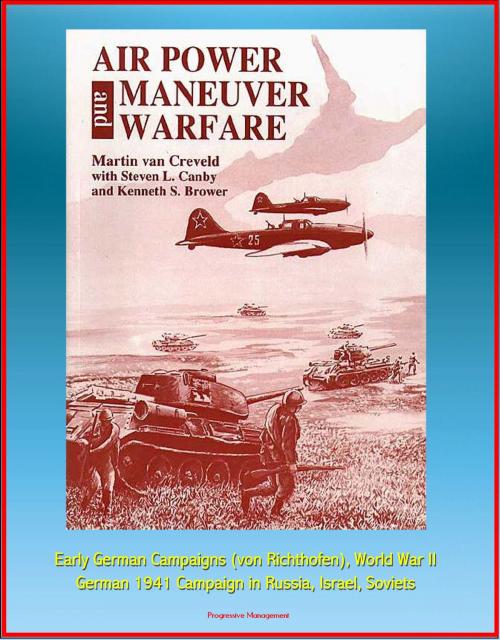Air Power and Maneuver Warfare - Early German Campaigns (von Richthofen), World War II, German 1941 Campaign in Russia, Israel, Soviets
Nonfiction, History, Military, Aviation, World War II| Author: | Progressive Management | ISBN: | 9781476352718 |
| Publisher: | Progressive Management | Publication: | August 21, 2012 |
| Imprint: | Smashwords Edition | Language: | English |
| Author: | Progressive Management |
| ISBN: | 9781476352718 |
| Publisher: | Progressive Management |
| Publication: | August 21, 2012 |
| Imprint: | Smashwords Edition |
| Language: | English |
This unique volume represents an attempt "to clarify the relationship between air power and maneuver warfare since 1939, a subject that derives its importance from the fact that maneuver warfare has been the Army's official doctrine since the early eighties...[it will help the reader learn] about the past, present, and future of air power on one hand and maneuver warfare on the other."
To address the relationship between air power and maneuver warfare, including the logistic aspect of the latter, this study is constructed as follows. Chapter 1 is analytical, offering a discussion of the nature of maneuver warfare, its dominant concepts, and the way of thought that it represents. Chapters 2, 3, 4, and 5 consist of case studies. Arranged in chronological order, they describe the German campaigns in Spain (1936) and in France and the Low Countries (1940), the German campaign in Russia (1941), Soviet operational warfare (1941-45), and the Israeli experience (1967 and 1973), respectively. The final chapter pulls the threads together. In essence, it argues that maneuver implies a transformation of applied air power from "tactical" to "operational," with a corresponding shift in the method of sortie allocation and aircraft mix. In maneuver warfare, close-in battlefield interdiction is as important as ever but is becoming increasingly an army mission undertaken by attack helicopters and multiple launch rocket systems (MLRS). Further behind the enemy's front, operational air warfare entails a shift away from random attacks against supply lines towards a highly focused effort to destroy follow-up forces, prevent counterattacks, and isolate the battlefield. This shift in the use of air forces from tactical to operational is akin to using a fission weapon as a trigger for a fusion device. Whereas "tactical" merely uses the power of tactical aviation on its own, "operational" leverages it and produces new levels of synergy in the interactions of ground and air forces.
CONTENTS * FOREWORD * PREFACE * INTRODUCTION * Notes * CHAPTER 1 * THE NATURE OF THE BEAST * Notes * CHAPTER 2 * MANEUVER WARFARE IN ACTION—EARLY GERMAN CAMPAIGNS * Notes * CHAPTER 3 * MANEUVER WARFARE IN ACTION—THE GERMAN 1941 CAMPAIGN IN RUSSIA * Notes * CHAPTER 4 * MANEUVER WARFARE IN ACTION—THE SOVIET VERSION * Notes * CHAPTER 5 * ISRAEL: MANEUVER WARFARE, AIR POWER, AND LOGISTICS * Notes * CHAPTER 6 * MANEUVER WARFARE AND AIR POWER IN THE 1990s * Past Limitations on Air Power * Air Power and New Developments * Hardware * Situational * The Cordon Sanitaire of Reconstruction * Differences in Styles of War for Air Power * Notes * APPENDIX * THE INSTITUTE RESPONDS * BIBLIOGRAPHY
This unique volume represents an attempt "to clarify the relationship between air power and maneuver warfare since 1939, a subject that derives its importance from the fact that maneuver warfare has been the Army's official doctrine since the early eighties...[it will help the reader learn] about the past, present, and future of air power on one hand and maneuver warfare on the other."
To address the relationship between air power and maneuver warfare, including the logistic aspect of the latter, this study is constructed as follows. Chapter 1 is analytical, offering a discussion of the nature of maneuver warfare, its dominant concepts, and the way of thought that it represents. Chapters 2, 3, 4, and 5 consist of case studies. Arranged in chronological order, they describe the German campaigns in Spain (1936) and in France and the Low Countries (1940), the German campaign in Russia (1941), Soviet operational warfare (1941-45), and the Israeli experience (1967 and 1973), respectively. The final chapter pulls the threads together. In essence, it argues that maneuver implies a transformation of applied air power from "tactical" to "operational," with a corresponding shift in the method of sortie allocation and aircraft mix. In maneuver warfare, close-in battlefield interdiction is as important as ever but is becoming increasingly an army mission undertaken by attack helicopters and multiple launch rocket systems (MLRS). Further behind the enemy's front, operational air warfare entails a shift away from random attacks against supply lines towards a highly focused effort to destroy follow-up forces, prevent counterattacks, and isolate the battlefield. This shift in the use of air forces from tactical to operational is akin to using a fission weapon as a trigger for a fusion device. Whereas "tactical" merely uses the power of tactical aviation on its own, "operational" leverages it and produces new levels of synergy in the interactions of ground and air forces.
CONTENTS * FOREWORD * PREFACE * INTRODUCTION * Notes * CHAPTER 1 * THE NATURE OF THE BEAST * Notes * CHAPTER 2 * MANEUVER WARFARE IN ACTION—EARLY GERMAN CAMPAIGNS * Notes * CHAPTER 3 * MANEUVER WARFARE IN ACTION—THE GERMAN 1941 CAMPAIGN IN RUSSIA * Notes * CHAPTER 4 * MANEUVER WARFARE IN ACTION—THE SOVIET VERSION * Notes * CHAPTER 5 * ISRAEL: MANEUVER WARFARE, AIR POWER, AND LOGISTICS * Notes * CHAPTER 6 * MANEUVER WARFARE AND AIR POWER IN THE 1990s * Past Limitations on Air Power * Air Power and New Developments * Hardware * Situational * The Cordon Sanitaire of Reconstruction * Differences in Styles of War for Air Power * Notes * APPENDIX * THE INSTITUTE RESPONDS * BIBLIOGRAPHY















